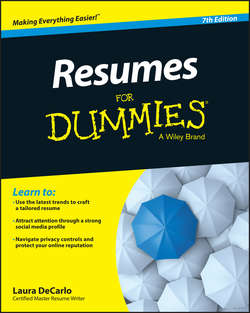Читать книгу Resumes For Dummies - DeCarlo Laura - Страница 7
На сайте Литреса книга снята с продажи.
Part I
Getting Started with Resumes
Chapter 1
Seeing How the Digital Age Is Changing the Job Chase
Technologies Facilitate Job Search
ОглавлениеAfter the Internet caught job-search fire in the mid-1990s – instantly whisking resumes to and fro – little new technology changed the picture until the social web groundswell burst upon us in the mid-2000s. Now job seekers have the tools to
✔ Use social networks to dramatically enlarge personal networks
✔ Tap their networks to identify jobs and for recommendations
✔ Go directly to hiring authorities
✔ Market accomplishments in professional profiles
✔ Pinpoint employment targets with position-mapping
Continue to apply for jobs with an OnTarget resume and cover letter. Classic job-search methods continue to pay off, but they’re not enough in an economy where jobs have gone missing.
Work every day on a well-rounded approach that emphasizes face-to-face networking, social networking, web tools, online identity building, and professional associations while still briefly touching on less viable elements such as job boards and print ads.
Social networking scoops jobs
Enormously popular social networking sites and social media are poised to gain even more fans in the employment process. Chapter 2 reports on the state of the industry and suggests how you can “go social.”
I expect a never-ending stream of new technical bells and whistles in social media. Location awareness is one example of what’s rapidly gaining in use. When Facebook launched its Places feature in late 2010, social media expert Charlene Li explained: “Until now, Facebook knew who you were, what you are doing, and when you did it. Now they add an even richer dimension – where you are – that completes the picture.” Facebook added Places to its posts, a smartphone app, and a mobile site.
How can a location-aware feature facilitate a job chase? Suppose you’re looking for a retail or restaurant job in a given locale. The activity stream of a location feature indicates which restaurants and retail stores are the most popular – and, thus, good prospects for employment.
For breaking news about social networking, become acquainted with the following two websites:
✔ Mashable (www.mashable.com) is a top guide to social media and a hub for those looking to make sense of the online realm.
✔ Altimeter Group (www.altimetergroup.com) focuses on all things social, including the new field of social commerce. Be sure to read the Group’s admirable disclosure policy.
Chapter 5 discusses ways to keep your online reputation in good shape for the job search.
Mobile’s on the move
Smartphones came on fast. Tablet computers are all the rage. Mobile communication is here to stay. Even when you’re not rooted to a desktop computer, you can send and receive e-mails, network online, and download apps. Chapter 3 examines the latest in mobile job chasing.
Quick-change process customizes content
In this employers’ market, you need to become 100 times more strategic and savvy in writing OnTarget resumes and getting them to the key decision makers. The generic resume has become a nonstarter, and successful seekers are writing customized resumes.
But have no fear: In Chapter 9, I take you through how to turn a one-size-fits-all Core resume into OnTarget resumes with ease.
Bios gain new importance as profiles
The short professional bio is making a comeback as a social profile (see Chapter 2). The short bio helps when you want to apply for a job, network, post on a guest blog, and so on. It tells people quickly who you are, what you do, and why they should care.
Plan on writing a bio in three lengths – a micro bio, a short bio, and a longer bio. A micro bio is a sentence you can use on your Twitter profile (140 characters). A short bio is a paragraph (about 100 words). A long bio can be up to a page.
“YourName.com” becomes vital
More people are living their lives on the Internet, and episodes of name high-jacking are rising. Realization is mushrooming that controlling the exclusive online rights to your own name makes sense, even if you’re not a business owner.
You can protect your identity in its purest web form by buying a domain for your name – YourName.com. You can also purchase a URL (web address) for your resume – YourNameresume.com. See Chapters 2 and 5 to find out why owning your own name has gained red-alert status in a digital age. Claim your name!
